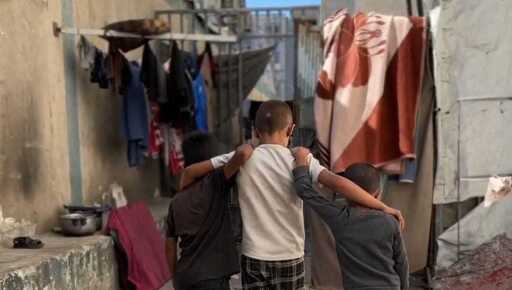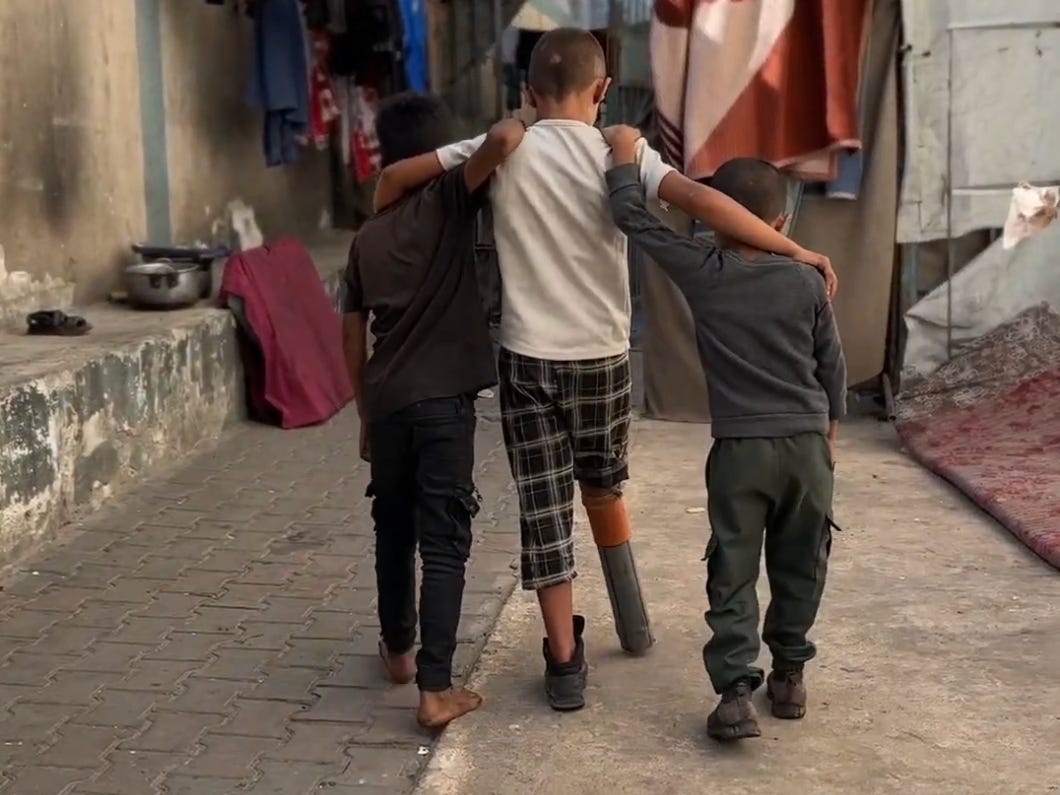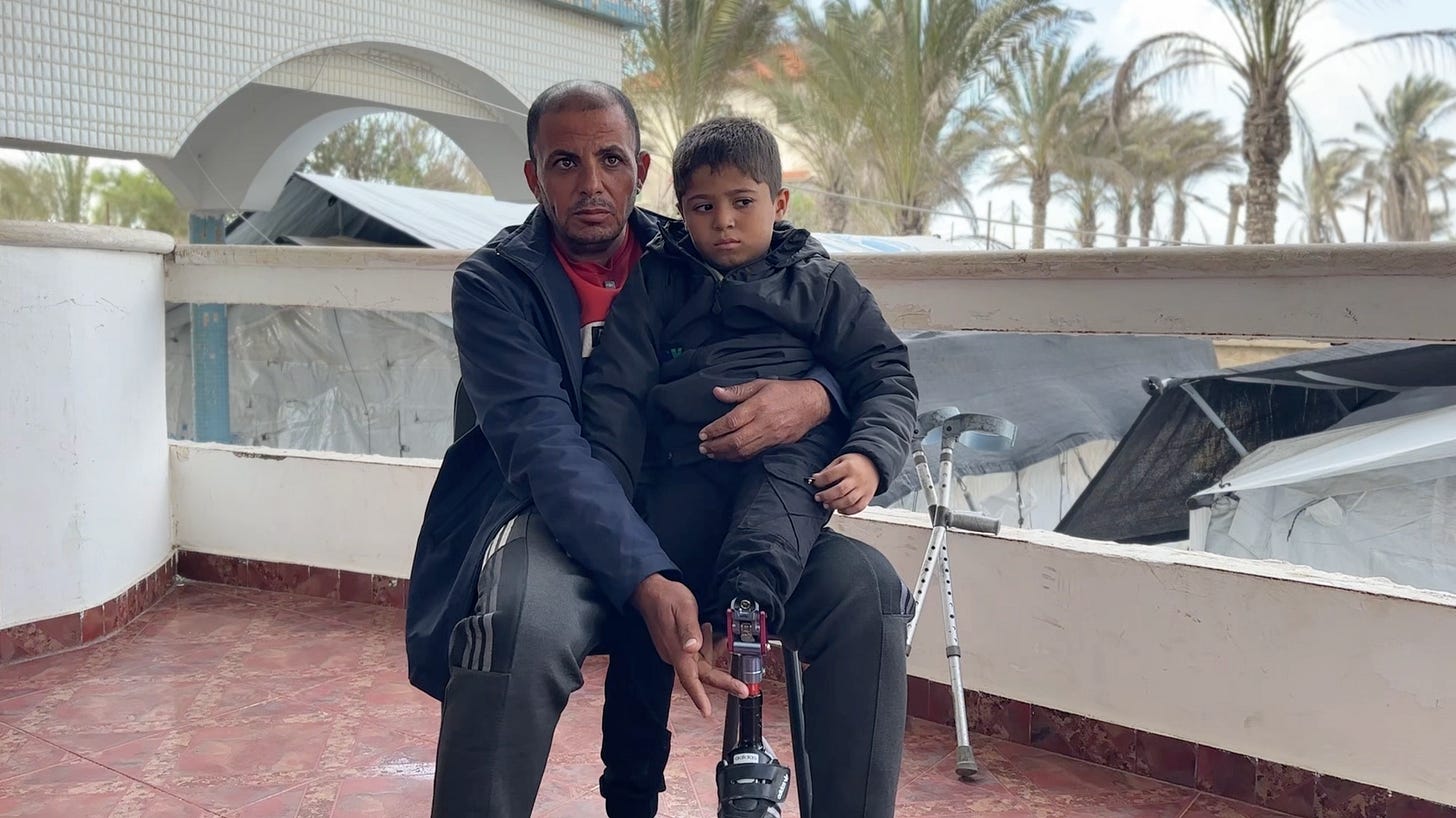Drop Site is a reader-funded, independent news outlet. Without your support, we can’t operate. Please consider making a 501©(3) tax-deductible donation today.
Rateb Abu Qleiq, 10, walks on a makeshift prosthetic leg with the help of two friends in Deir al-Balah. November 2025. (Screen shot of video courtesy of Abdel Qader Sabbah.)
DEIR AL-BALAH, GAZA STRIP—Ten-year-old Rateb Abu Qleiq sat in a rusted chair in front of his tent in Deir al-Balah. As he spoke, he unconsciously swung his right leg, which was amputated just below the knee, back and forth—the stub tracing a short arc in the air. On his lap he cradled a makeshift prosthetic, nothing more than a piece of plastic sewage pipe outfitted with an orange covering secured by a piece of string.
“My leg is gone,” Rateb told Drop Site. “This pipe doesn’t make up for my leg.”
Rateb was severely wounded in an Israeli airstrike in Khan Younis earlier this year that killed his mother and brother. His right leg was crushed and had to be amputated. He has undergone five surgeries in his abdomen since the attack.
“I felt sad that I’m no longer like the other kids because my leg was amputated. I don’t know how to play with them. I wish I had a leg so I could play with my friends,” he said.
Desperate to move again, Rateb and his cousin fashioned the prosthetic leg out of a plastic sewage pipe he found in the street. “I don’t want to give up, and my determination is strong. I dream of having a real prosthetic limb,” Rateb said. “If my leg hadn’t been cut off, the first place I’d go is the field to play football. I want to return to our home and have my mom, my dad, and my leg with me.”
Rateb Abu Qleiq, 10, fashioned a makeshift prosthetic limb out of a plastic sewage pipe after his right leg was amputated following an Israeli airstrike. Deir al-Balah. November 2025. (Video courtesy of Abdel Qader Sabbah.)
“When he first wore it, he was so happy, as if it were his real leg, he would walk on it. But poor thing, because it was made of plastic, it started to hurt his leg. No matter what, it’s still just a sewage pipe,” Rateb’s uncle, Mohammed Abu Qleiq, told Drop Site. “It doesn’t replace a real prosthetic limb, and it doesn’t make up for his leg. But this was the simplest thing we had.”
“Rateb has lost everything. He is the only survivor from his family, with only his sister and brother left. Rateb lost his mother, he lost his brother, and his father is out of Gaza so doesn’t even see him anymore,” Abu Qleiq added. “He’s also deprived of the most simple joys of life, like playing with his friends, walking, and seeing his friends.”
Along with the nearly 70,000 Palestinians confirmed killed in Gaza over the past two years, Israel’s genocidal war has wounded over 170,000, according to the Gaza Ministry of Health. A recent report by the World Health Organization (WHO) found that nearly a quarter of those injuries are potentially life-changing, with over 41,000 people—or nearly 2% of Gaza’s population—affected. Up to a quarter of those are children. In August, as Israel’s military assault was continuing in full force, the UN said an average of ten children were losing one or both legs every day.
In September, the United Nations Committee on the Rights of Persons with Disabilities reported that at least 21,000 Palestinian children had been disabled in Gaza since October 2023. Earlier this month, the Ministry of Health announced that over 6,000 amputation cases had been registered, with children comprising 25% of the total, making Gaza home to the highest number of child amputees per capita in the world.
“These figures reflect the profound human suffering endured by thousands of injured individuals and their families, highlighting the urgent need for rehabilitation services and psychosocial support, especially for children who have found themselves facing permanent disabilities at a young age,” the health ministry said in a statement.
Blast injuries remain the most common form of injury, according to the WHO report, with amputations, burns, spinal cord injuries and traumatic brain injuries, most in need of rehabilitation.
Yet rehabilitation services in Gaza, like the health care system as a whole, are under enormous strain. Before the war, the Hamad Hospital for Rehabilitation and Prosthetics in Gaza City, which is funded by the Qatar Development Fund, was the only hospital specializing in prosthetics and rehabilitation in the Gaza Strip. In October 2023, at the outset of the war, the hospital sustained heavy damage from Israeli shelling and airstrikes, and was eventually forced to close the following month after repeated attacks in the area. The hospital was hit several more times in the ensuing months.
Following the so-called “ceasefire” that went into effect on October 10, the Hamad hospital opened a branch in Al-Zuwaida in central Gaza. Its rooms are filled with Palestinians undergoing rehabilitation and treatment, mostly for amputated limbs. In one room a child practiced walking on a prosthetic leg, first on a flat service then on an uneven one made of foam. Much of Gaza has been reduced to rubble, with no sidewalks or streets, let alone ramps or accessible access for the disabled.
Patients receive treatment at the Hamad Hospital for Rehabilitation and Prosthetics in Al-Zuwaida. November 2025. (Video by Abdel Qader Sabbah.)
“The prosthetics department is working hard to provide the best services to these amputation cases. Approximately 100 cases have benefited from receiving prosthetic limbs,” Ahmed Jamal Al-Absi, the head of the prosthetics department at Hamad Hospital, told Drop Site.
While the facility specializes in molding and creating prosthetics, they have run out of raw materials as Israel continues to heavily restrict medical supplies to Gaza in violation of the ceasefire agreement. “The materials are running out after fitting about 100 prosthetic limbs,” Al-Absi said. “Now we are entering a situation where there can be no prosthetic limbs. Since 2023, no materials for prosthetics have entered the stock. We are trying hard, along with international organizations and our partner institutions, to coordinate the entry of these materials due to the closure of the crossings.”
“Some cases have already been registered for travel abroad, as there are complex cases that require surgery abroad and the provision of prosthetic limbs. But with such a large number, we cannot serve them all at Hamad Hospital,” he added.
The Hamad Hospital in Al-Zuwaida molds and fashions prosthetics with limited resources. November 2025. (Video by Abdel Qader Sabbah.)
Gaza once had around 1,300 physiotherapists and 400 occupational therapists but dozens have been killed in Israeli attacks and many more injured or displaced. “The conflict has devastated the rehabilitation workforce,” the WHO said. “Despite the huge number of amputations, Gaza has only 8 prosthetists to manufacture and fit artificial limbs. “
The few Palestinians who have managed to receive prosthetic limbs and rehabilitation call themselves fortunate. Five-year-old Ahmad Murad Ashour was injured in an Israeli strike in April 2025 as he was walking down the street. The injury to his left leg led to an initial amputation below the knee, though complications led to a second amputation higher up at the joint. Months later, he was eventually able to be fitted for a prosthetic leg at Hamad hospital.
Ahmad Murad Ashour, 5, had his left leg amputated at the knee after he was injured in an Israeli airstrike in April 2025. He was fitted for a prosthetic leg at the Hamad hospital in Al-Zuwaida. November 2025. (Screenshot of video by Abdel Qader Sabbah.)
“We’ve been taking him to hospitals for so long. We faced many difficulties,” his father, Abu Ahmad, told Drop Site. “We applied for him to travel abroad, and his referral was ready—so we can continue his treatment. He, along with his brother, who was also injured, need further medical care. We came to the hospital here, and they fitted him with a prosthetic leg…thank God for everything.”
“We struggled a lot to get him a prosthetic,” Abu Ahmad continued. “I see many, many cases in Gaza. I see them as I walk down the street. My son’s case is one thing, but there are children without legs, without arms. This is all happening in our country.”
Drop Site News Middle East Research Fellow Jawa Ahmad contributed to this report. Sami Vanderlip edited the video.
From Drop Site News via this RSS feed




